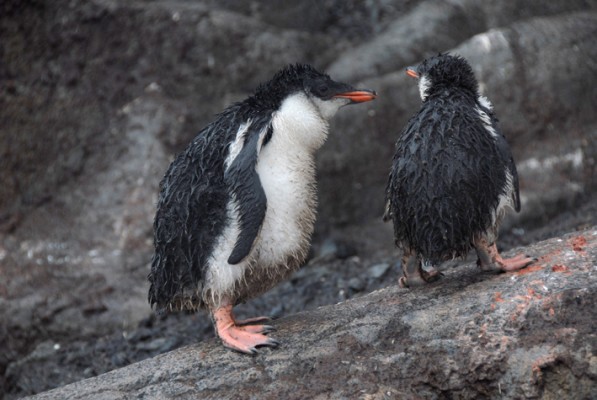Today is one of those days down here that you wish you could be sitting by some kind of warm fire, whether in the comfort of your living room or a preferably a bonfire. At eight this morning it is thirty-four degrees and raining, conditions which began yesterday and promise to be with us for at least two more. Thanks to satellite imagery we are able to track the weather up to five days in advance, more or less; at the very least we know when high and low pressure systems are on the way and from what direction to expect the winds.
Loading into a hypalon Zodiac — Graham Charles, an old friend of mine and great Kiwi explorer, Skip Novak, a longtime sail racer and owner of the “Pelagic Australis” that sailed us to Antarctica and myself — round the southwestern edge of Enterprise Island to have a look at the art show of grounded icebergs that gather in the relatively shallow waters each summer season.
We are not disappointed. Twenty and thirty foot tall icebergs litter the alley. One has a pair of small arches carved through it by wind and waves. Another has a sheer wall, like smooth granite, rising straight out of the cold sea. Another is ridged by undulations carved into its underside over many years before it rolled onto its side.
Graham, who has kayaked the length of the Peninsula and works every season as an expedition leader aboard one of the 30+ tourist ships that come south each season, is almost apologetic for the rain and gray. “It’s so unusual these days to see so many back to back days without sun. We’ve gotten spoiled by weeks recently where there’s been nothing but blue sky and glassy seas.”
Skip, who first sailed to Antarctica in the early 1980s and is one of a small handful of charter boat captains whose boats have returned each season since, agrees. “But even when you say that, I think back to conditions twenty years ago when we had far more wind. And back then, every morning you’d wake up to snow on the boat, which we almost never see now. It’s simply too warm to snow.”
Perhaps the most beautiful part of Antarctica, even on a gray, misty day, is just how much it changes from year to year. I’ve been to this corner of Enterprise more than a dozen times and the ice that surrounds it changes every 15 minutes. Sometimes by the light glancing off it or, like today, the mist that envelops it, or the wind and waves moving it up and down, from side to side, threatening to flip it onto its side.
Without question the biggest change to come to the Peninsula in my 20 years of experience down here is the weather. Today during the austral summer, November to February, each year is warmer and wetter. It’s not just my imagination: Data collected at the various science bases along this stretch of the continent detail that air and sea temperatures have risen dramatically in the past 40 years. During the summer, average temps have risen up 5 to 10 degrees F; year round, the average temps along the Peninsula, including during its long, cold, dark winters, have raised by up to 18 degrees.
The warmer conditions are relevant to us because they deliver more precipitation, i.e. rain. Our hope is that this will be a summer filled with many clear days, in large part because we’re trying to capture Antarctica in 3D … and we don’t want the audience to come away thinking the place is only gray, misty and wet.
Conditions have been making filming tricky during these early days of our exploration. A drop of snow or salty sea spray on the 18” mirror or one of two camera lenses on the Epic 3D rig means lots of stopping and starting, stopping and starting. The result is long days and lots of waiting.
But the delays are worth it. The beauty down here is that when the sun does shine it’s like watching a Disney film on hallucinogens, surrounded everywhere you look by ice in its thousands of forms.

